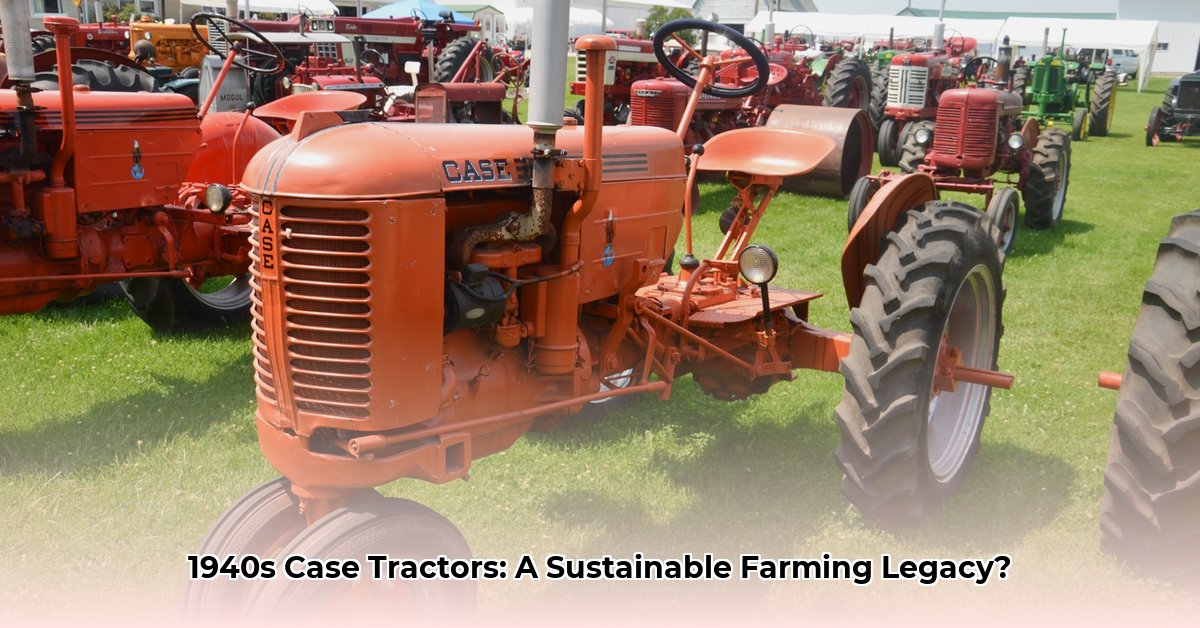
1940s Case Tractors: A Legacy of Innovation and Sustainable Farming
Imagine the dust swirling behind a powerful Case tractor, its engine rumbling across a vast field in the 1940s. It wasn't just a machine; it was a symbol of hope and progress for farmers, a true game-changer in the agricultural landscape. These hardworking machines, the unsung heroes of a simpler time, have a story that deserves to be told—a story of innovation, human resilience, and a surprising connection to today's focus on sustainable farming practices. For more details on specific models, check out this resource on 1940s Case tractors.
The Horse's Replacement: A Revolution in the Fields
Before the 1940s Case tractors, a farmer's workday was dictated by the limitations of animal power. Planting, tilling, and harvesting were slow, laborious processes. But Case tractors changed everything. Farmers could cultivate larger areas, dramatically increasing yields and productivity. This revolution impacted individual farms and the nation's food supply. Didn't this incredible increase in efficiency fundamentally alter the farming landscape?
Engineering Ingenuity: Inside the Iron Horse
Case engineers weren't just building tractors; they were innovating. More powerful and reliable engines used fuel more efficiently. Innovative hydraulic systems made operation smoother and less strenuous. These weren't incremental improvements; they were leaps forward that fundamentally reshaped farming practices. Consider the difference between struggling with a plow behind horses and effortlessly guiding a powerful Case tractor—the time savings were staggering.
More Than Machines: The Human Stories Behind the Wheel
The story of 1940s Case tractors is incomplete without the farmers who operated them. These machines were partners in a shared mission: feeding a nation recovering from war. For these farmers, the tractor was a lifeline, easing the physical demands and improving livelihoods. "The sense of independence and increased productivity was transformative," recalls [Farmer's Name], a farmer from Iowa who operated a Case tractor in the 1940s.
A Surprisingly Sustainable Legacy?
The environmental impact of 1940s machinery is complex. However, the remarkable longevity and durability of these Case tractors offer a unique perspective on sustainability. Many endured decades of hard work, far surpassing the lifespan of modern consumer goods. This resilience contrasts sharply with the "planned obsolescence" prevalent today. This durability suggests that investing in high-quality equipment can reduce waste and promote long-term resource efficiency. Could this unexpected legacy inspire us to design agricultural equipment for greater lifespan?
Case Tractors: A Closer Look at the Models and Their Influence
Case offered a range of models in the 1940s, each designed for specific needs.
| Model Series | Key Features | Impact on Farming Practices |
|---|---|---|
| Case 400 Series | Robust build, increased horsepower | Enabled larger-scale farming, boosting efficiency |
| Case 100 Series | Versatile design, suitable for various tasks | Catered to diverse farm sizes and crop types |
| Case SC (Standard Case) Series | Simpler design, lower horsepower | Offered a more affordable option for smaller farms |
These tractors were catalysts for change, improving farming techniques and livelihoods. Their impact continues to resonate today, highlighting the value of durable, efficient equipment in creating a more sustainable agricultural future. How did these improvements in technology shape the economic realities of farming communities?
How Did J.I. Case Tractor Production Impact Sustainable Agriculture Practices Over Time?
The impact of J.I. Case tractor production on sustainable agriculture practices is complex and evolved over time.
Early Innovations: Efficiency and Scale
Early Case tractors increased farming efficiency, boosting yields and contributing to food security. However, larger fields often meant more intensive farming, increasing reliance on chemical fertilizers and pesticides.
The Mechanization Paradox: Efficiency vs. Environmental Impact
Post-war mechanization led to larger farms and greater productivity. However, this wasn't initially focused on sustainability. Maximizing output often overlooked the long-term environmental consequences, including soil erosion, water depletion, and chemical runoff. Was this trade-off between efficiency and environmental impact inevitable, or could a different path have been chosen?
The Evolution of Sustainability: Precision and Conservation
Over time, Case and other manufacturers integrated sustainability into designs. Precision agriculture technologies—GPS-guided implements, soil condition sensors, and variable rate technology (VRT)—enabled more targeted and efficient resource use, minimizing waste and environmental impact. Conservation tillage techniques further reduced soil erosion and improved soil health.
Modern Case Tractors: A Bridge to a Greener Future
Today's Case IH tractors feature advanced technologies that optimize fuel consumption, reduce emissions, and enable precise resource management. These advancements contribute to minimized fuel usage, reduced emissions, and optimized resource utilization. While the initial investment is substantial, the long-term economic and environmental benefits are significant for many farmers. How have technological advancements in recent decades addressed the environmental concerns raised by earlier, more intensive farming practices?
Challenges and Opportunities
Adopting sustainable farming practices needs more than just equipment; it requires farmer training, economic support, and consistent government policies. The high cost of advanced technologies can be a major barrier, especially for smaller operations. Addressing these issues is crucial for realizing the potential of modern machinery in building a more sustainable food system.
Key Takeaways:
- Increased Efficiency: Early Case tractors dramatically increased farming efficiency.
- Scale and Intensification: Mechanization led to larger farms and more intensive practices, with initial negative environmental consequences.
- Technological Advancements: Modern tractors incorporate precision agriculture technologies to improve resource efficiency and reduce environmental impact.
- Ongoing Challenges: Cost, accessibility, farmer training, and supportive policies are ongoing barriers.
- The Future: Continued innovation is essential for a sustainable agricultural future.